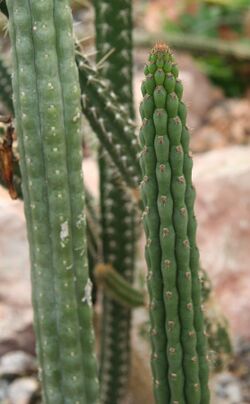Biology:Yungasocereus
| Yungasocereus | |
|---|---|

| |
| Scientific classification | |
| Kingdom: | Plantae |
| Clade: | Tracheophytes |
| Clade: | Angiosperms |
| Clade: | Eudicots |
| Order: | Caryophyllales |
| Family: | Cactaceae |
| Subfamily: | Cactoideae |
| Tribe: | Cereeae |
| Subtribe: | Trichocereinae |
| Genus: | Yungasocereus F.Ritter[3] |
| Species: | Y. inquisivensis
|
| Binomial name | |
| Yungasocereus inquisivensis (Cárdenas) F.Ritter[2]
| |
| Synonyms[2] | |
| |
Yungasocereus is a monotypic genus of cacti. Its sole species is Yungasocereus inquisivensis, native to Bolivia.[3]
Description
It is a columnar cactus, appearing either as a tree or shrub, ranging up to 4–5 meters in height. The 6–7 cm diameter stems are dark green, with 6-10 ribs. The 1.5–3 cm spines are in groups of 4-12, with no differentiation into central and radial types, and range from a brownish to grayish color. The flowers are white, appearing in groups of 5-8 near the stem tips. They open day and night and are 5 to 6 centimeters long.
The fruits have a length between 2 and 2.8 centimeters. They contain small, broadly oval, shiny black, slightly keeled seeds on the back, 0.9 millimeters long and 0.7 millimeters wide.[4]
Taxonomy
Martín Cárdenas described the species in 1957 from Inquisivi, placing it in Samaipaticereus.[5] Friedrich Ritter later found the same species in Yungas. In 1980, he gave the cactus its own genus, Yungasocereus.[6] After a period in Haageocereus, this was again separated into Yungasocereus.
Distribution
This cactus is known only from Yungas and Inquisivi provinces of La Paz Department, where it is found at elevations of around 1000 to 2300 meters.[citation needed]
References
- ↑ "The IUCN Red List of Threatened Species". IUCN Red List of Threatened Species. 2010-09-22. https://www.iucnredlist.org/species/152313/121587460. Retrieved 2023-09-04.
- ↑ 2.0 2.1 "Yungasocereus inquisivensis (Cárdenas) F.Ritter" (in en). Royal Botanic Gardens, Kew. http://www.plantsoftheworldonline.org/taxon/270454-2.
- ↑ 3.0 3.1 "Yungasocereus F.Ritter" (in en). Royal Botanic Gardens, Kew. http://www.plantsoftheworldonline.org/taxon/893012-1.
- ↑ Anderson, Edward F.; Eggli, Urs (2005) (in de). Das grosse Kakteen-Lexikon. Stuttgart (Hohenheim): Ulmer. p. 646. ISBN 3-8001-4573-1.
- ↑ "Au Cactus Francophone" (in fr). https://www.cactuspro.com/lecture/Cactus_Paris/Cactus_Paris-1957-57/page-19.de.html.
- ↑ "Au Cactus Francophone" (in fr). https://www.cactuspro.com/lecture/Ritter-Friedrich/KakteenSudamerika2/page-300.de.html.
- Edward F. Anderson, The Cactus Family (Timber Press, 2001), p. 681
External links
Wikidata ☰ {{{from}}} entry
 |


